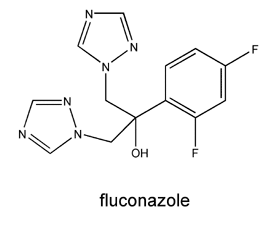Manufacturer’s Prescribing Information
Trade & Generic Names & General Features
Fluconazole is a widely used bis-triazole antifungal agent. As with other triazoles, it has five-membered ring structures containing three nitrogen atoms. It is marketed as Diflucan® by Pfizer Pharmaceuticals ((E):http://www.pfizer.com(E):). Both oral and intravenous formulations of fluconazole are available.

Mechanism(s) of Action
As with all azole antifungal agents, fluconazole works principally by inhibition of cytochrome P450 14a-demethylase (P45014DM). This enzyme is in the sterol biosynthesis pathway that leads from lanosterol to ergosterol [1394, 1445, 1674].
Susceptibility Patterns
Fluconazole is generally considered to be a fungistatic agent. It is principally active against Candida spp. and Cryptococcus spp. However, Candida krusei is intrinsically resistant to fluconazole. Also, isolates of Candida glabrata often generate considerably high fluconazole MICs, with as many as 15% of isolates being completely resistant [1784]. Acquired resistance to fluconazole among Candida albicans strains has been reported particularly in HIV-infected patients [267, 464, 1049, 1912].
Fluconazole has useful activity against Coccidioides immitis and is often used to suppress the meningitis produced by that fungus [793]. It has limited activity against Histoplasma capsulatum [2414], Blastomyces dermatitidis [1713], and Sporothrix schenckii [856, 1169], and is sometimes used a second-line agent in these diseases. Fluconazole has no meaningful activity against Aspergillus spp. or most other mould fungi [267, 571].
For fluconazole MICs obtained for various types of fungi, see susceptibility patterns and the N/A(L):susceptibility database.
Usual Doses
For oropharyngeal candidiasis, and other forms of mucocutaneous candidiasis, fluconazole is typically dosed at 50-150 mg/day. For invasive candidiasis, the commonly applied dose is ~6 mg/kg/day, or 400 mg in the typical 70 kg adult. Doses of ~12 mg/kg are not FDA-approved, but are used with increasing frequency due to the desire to achieve higher blood levels and thus extend the range of use of the drug. Even higher doses (up to 30 mg/kg in one report!) have been used safely [68, 236, 998, 1519, 2342]. Fluconazole is excreted by the kidneys, and the dose should be reduced in proportion to any reduction of kidney function [545].
Side-Effects
Fluconazole is generally quite well tolerated. In common with all azole antifungal agents, fluconazole may cause hepatotoxicity.
Routes
Fluconazole has both oral and intravenous formulations.
Current Status
Fluconazole is a very widely used antifungal agent. It is one of the first-line drugs, particularly in treatment of infections due to Candida spp. other than Candida krusei and some Candida glabrata isolates. Fluconazole is commonly used also for prophylaxis in transplant patients [1730, 2453].
